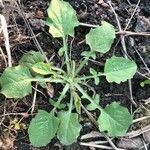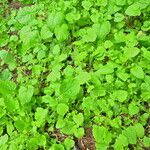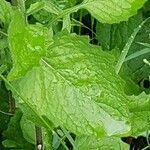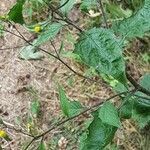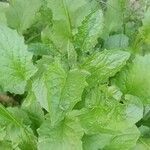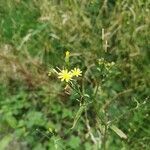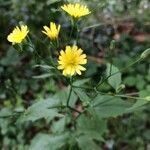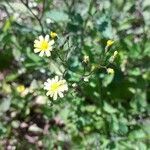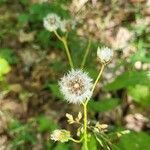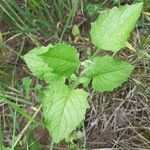Hirsute to subglabrous weed 1.5–15 dm; lvs thin, petiolate, with ovate to subrotund, obtuse or rounded, toothed or occasionally basally lyrate blade 2.5–10 × 2–7 cm, progressively less petiolate and eventually narrowed upwards; heads naked-pedunculate, several or many in a corymbiform or paniculiform infl; invol 5–8 mm, with 8 inner bracts; fls 8–15; achenes 3–5 mm, glabrous, curved; 2n=12, 14, 16. Woods, fields, and waste ground; native of Eurasia, now found throughout our range. June–Sept.
A medium sized annual herb. The stems are erect. It can be 1.5 m tall. It does not have milky latex when cut. It may or may not have branches. The leaves are oval and have teeth. The leaves are often lobed at the base. The lower leaves have stalks and the upper leaves are smaller and do not have stalks. The flowers heads are yellow and 10-20 mm across. They are borne in loose branched flower arrangements. The florets all have rays. The flower bracts are sword shaped. They are erect.
Plant 10-125 cm. Leaves 10-150 x 10-70 mm, ovate and dentate to lyrate-pinnatifid with a large terminal lobe and small lateral lobes, the upper sessile or shortly petiolate, sometimes lanceolate and entire, the lower long-petiolate. Capitula in a more or less corymbose panicle. Involucre 5-10 x 2-5 mm; inner bracts linear-oblong, more or less obtuse, keeled in fruit; outer 0.5-1 mm, few, ovate-lanceolate. Achenes 2.5-9 mm, the outer much longer than the inner.
Leaves: blades 1–15(–30) × 1–7(–10) cm. Heads 5–25(–100+). Calyculi: bractlets keeled in fruit, 0.5–1 mm. Involucres 5–10 × 3–4 mm. Phyllaries 3–9 mm. Corollas 7–10 mm. Cypselae 3–5 mm. 2n = 12, 14, 16.
For description of subspecies occurring in Australia see Lapsana communis L. subsp. communis.
